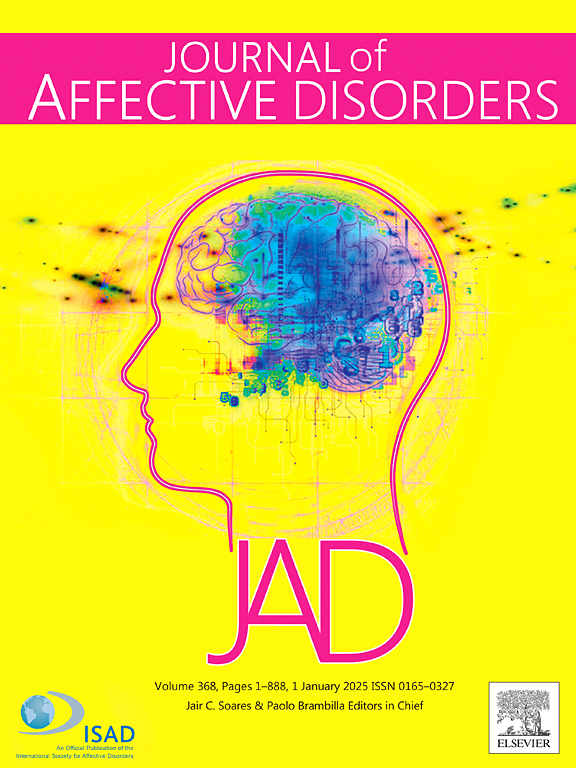Efficacy and acceptability of brain stimulation for anxiety disorders, OCD, and PTSD: A systematic review and network meta-analysis of randomized controlled trials
IF 4.9
2区 医学
Q1 CLINICAL NEUROLOGY
引用次数: 0
Abstract
Background
The present study aimed to conduct a systematic review and network meta-analysis to investigate the efficacy and acceptability of brain stimulation techniques (BSTs) for anxiety disorders, obsessive-compulsive disorder (OCD) and post-traumatic stress disorder (PTSD).
Methods
A comprehensive search was performed in Embase, PubMed, Web of Science, PsycINFO, Cochrane, ClinicalTrials.gov and HowNet databases for studies published before September 10, 2023. Randomized clinical trials that involved deep brain stimulation (DBS), electroconvulsive therapy (ECT), repetitive transcranial magnetic stimulation (rTMS), transcranial direct current stimulation (tDCS), sham therapy, or health control were included for analysis. The primary outcome was efficacy, while acceptability was considered as a secondary outcome.
Results
The sample consisted of 1333 patients with various anxiety disorders including social anxiety disorder, general anxiety disorder, panic disorder, social panic, obsessive-compulsive disorder, post-traumatic stress disorder, and agoraphobia, recruited from 41 trials with 86 treatment arms. Network meta-analysis showed that some BSTs had higher efficacy compared to controls, including DBS, ECT, cathodal tDCS, high-frequency rTMS (hf-rTMS), anodal tDCS, and low-frequency rTMS (lf-rTMS). Furthermore, hf-rTMS, lf-rTMS, and ECT had high acceptability in terms of odds ratio (OR).
Limitations
This study has limitations, including a focus on specific types of brain stimulation for anxiety disorders, OCD and PTSD and not considering factors like stimulation parameters. Future research should explore a broader range of technologies and parameters across various psychiatric and neurological conditions.
Conclusion
The study results suggest that BSTs are effective treatments for anxiety disorders, OCD and PTSD; lf-rTMS may be considered as the most promising option.
脑刺激治疗焦虑症、强迫症和创伤后应激障碍的疗效和可接受性:随机对照试验的系统回顾和网络荟萃分析。
研究背景本研究旨在通过系统综述和网络荟萃分析,探讨脑刺激技术(BST)治疗焦虑症、强迫症和创伤后应激障碍的疗效和可接受性:在 Embase、PubMed、Web of Science、PsycINFO、Cochrane、ClinicalTrials.gov 和 HowNet 数据库中对 2023 年 9 月 10 日之前发表的研究进行了全面检索。纳入分析的随机临床试验包括脑深部刺激(DBS)、电休克疗法(ECT)、重复经颅磁刺激(rTMS)、经颅直流电刺激(tDCS)、假治疗或健康对照。主要结果是疗效,而可接受性被视为次要结果:研究样本包括1333名患有各种焦虑症的患者,包括社交焦虑症、一般焦虑症、惊恐障碍、社交恐慌症、强迫症、创伤后应激障碍和广场恐惧症,这些患者来自41项试验,86个治疗臂。网络荟萃分析表明,与对照组相比,一些生物刺激疗法具有更高的疗效,包括DBS、ECT、阴极tDCS、高频经颅磁刺激(hf-rTMS)、阳极tDCS和低频经颅磁刺激(lf-rTMS)。此外,从几率比(OR)来看,高频经颅磁刺激、低频经颅磁刺激和电痉挛疗法的可接受性较高:本研究存在局限性,包括只关注治疗焦虑症、强迫症和创伤后应激障碍的特定脑刺激类型,而未考虑刺激参数等因素。未来的研究应探索更广泛的技术和参数,涵盖各种精神和神经疾病:研究结果表明,脑刺激疗法是治疗焦虑症、强迫症和创伤后应激障碍的有效方法;长波经颅磁刺激疗法可被视为最有前途的选择。
本文章由计算机程序翻译,如有差异,请以英文原文为准。
求助全文
约1分钟内获得全文
求助全文
来源期刊

Journal of affective disorders
医学-精神病学
CiteScore
10.90
自引率
6.10%
发文量
1319
审稿时长
9.3 weeks
期刊介绍:
The Journal of Affective Disorders publishes papers concerned with affective disorders in the widest sense: depression, mania, mood spectrum, emotions and personality, anxiety and stress. It is interdisciplinary and aims to bring together different approaches for a diverse readership. Top quality papers will be accepted dealing with any aspect of affective disorders, including neuroimaging, cognitive neurosciences, genetics, molecular biology, experimental and clinical neurosciences, pharmacology, neuroimmunoendocrinology, intervention and treatment trials.
 求助内容:
求助内容: 应助结果提醒方式:
应助结果提醒方式:


